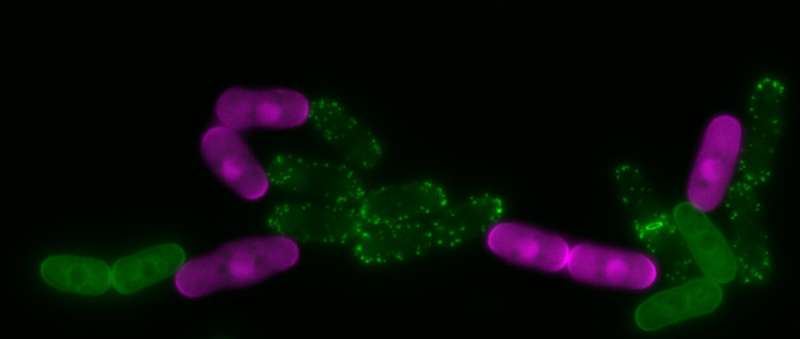Mechanism that allows cells to stop their polarized growth when under stress conditions described

The Oxidative Stress and Cell Cycle Research Group at UPF has discovered a mechanism whereby cells under stress conditions stop their polarized growth. The study, published in the journal Cell Reports, was led by Elena Hidalgo and José Ayté, and the first author is Clàudia Salat-Canela.
They have conducted this research on Schizosaccharomyces pombe yeast, an organism that has the advantage of possessing simple, easily-manipulated genetics, that allows handling many different conditions. Moreover, many of the basic molecular mechanisms of yeasts can be extrapolated to higher eukaryotic systems.
The researchers from the UPF Department of Experimental and Health Sciences are using cells from S. pombe to investigate how they react to oxidative stress, which may be caused by an external situation or by cellular respiration itself. The article has enjoyed the collaboration of the laboratory led by Pilar Pérez of the University of Salamanca, which uses S. pombe for the study of polarized growth. The Rho family of proteins is involved in the establishment and maintenance of polarized growth zones in all types of eukaryotic cells; through complex biochemical networks, this family of proteins controls fundamental processes of cell biology, such as growth, movement and cell division. The most relevant protein of this family is Cdc42.
The Rho family of proteins controls fundamental processes of cell biology, such as growth, movement and cell division.
Moreover, cells are also endowed with mechanisms to assess the conditions of the external environment and deal with possible stressors. These mechanisms are controlled by MAP kinase pathways. Specifically, this study focuses on the MAP kinase Sty1 pathway of S. pombe. When environmental conditions are not favorable, cell growth tends to slow down or stop. "Growth is costly for the cell, it is better to stop so that the cell can concentrate on other processes that allow it to cope with stress," Clàudia Salat explains.
These proteins are conserved from yeasts to mammals, suggesting that the basic mechanisms of cell polarization and response under stress conditions have been maintained throughout evolution.
In this work, the group has found the connection between the MAP kinase Sty1 pathway and the cell growth mechanisms driven by Cdc42. Specifically, the researchers describe that under stress conditions, Sty1 deregulates the equilibrium between Cdc42 activators and inhibitors. Contrary to what was initially expected, Sty1 not only affects one but several Cdc42 regulators. "The multiplicity of proteins involved in this process makes the system robust and ensures the inhibition of polarized growth under stress conditions," Clàudia Salat adds.
"These proteins are conserved from yeasts to mammals, suggesting that the basic mechanisms of cell polarization and response under stress conditions have been maintained throughout evolution," Dr. Salat-Canela explains. "Thus, this type of work with simple, easily manipulated models like yeasts, can reveal general molecular mechanisms," she concludes.
More information: Clàudia Salat-Canela et al, Stress-dependent inhibition of polarized cell growth through unbalancing the GEF/GAP regulation of Cdc42, Cell Reports (2021). DOI: 10.1016/j.celrep.2021.109951
Journal information: Cell Reports
Provided by Universitat Pompeu Fabra - Barcelona



















